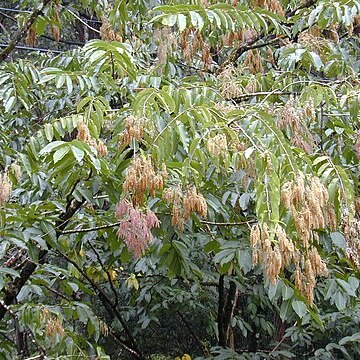Trees evergreen, to 35 m tall; trunk to 2.8 m d.b.h., with large buttresses. Branchlets cylindric, together with petioles glabrous, minutely brownish hirsute when young, or rarely densely brownish long stiff hirsute. Leaves opposite; petiole 0.5-1.5 cm, stout, with 2 stalked glands at apex; leaf blade oblong-elliptic or oblong-lanceolate, 10-25(-30) × 4-10(-15) cm, 2-4 × as long as wide, thickly papery, sparsely brownish hirsute abaxially and on veins adaxially when young, glabrescent or later glabrous, or rarely appressed yellowish brown sericeous when young, later sparsely (except on veins) hairy abaxially and subglabrous adaxially, base obtuse, margin entire or slightly undulate, rarely conspicuously toothed, apex with short, oblique tip; midvein yellow adaxially; lateral veins in 15-35 pairs. Inflorescences terminal or axillary, simple or compound, long, slender spikes, many grouped at branchlet apex and forming a large panicle 18-30(-50) cm; axes densely yellow tomentose. Calyx tube distally cupular, 2.5-3 mm, abaxially tomentose on ovary, glabrous on cupular part, adaxially tomentose; lobes 5. Stamens 10, exserted, 2-3 mm. Fruit not stipitate, yellowish when dry, 2-winged, 0.3-0.6 × 0.8-1.2 cm (broader than long); wings opposite, oblong, equal, membranous, sparsely pubescent, glabrescent, sometimes with 1 rudimentary wing seated between them. Fl. Aug-Sep, fr. Oct-Jan.
More
Large, evergreen tree. Young branchlets to-mentellous sometimes rapidly glabrescent. Leaves subopposite, at first tomentellous or appressed-pubescent, often glabrescent when mature, oblong, oblong-ellptic or oblong-lanceolate, 8-20 by 2-8 cm, pointed at the apex, rounded or subcordate at the base; nerves up to 20-30 pairs; petiole tomentellous often glabrescent, relatively short and thick, 3-4(-7) mm, often 1 or 2 conspicuous glands (sometimes stalked) at the apex of the petiole or at the base of the lamina. Flowers small, sessile, numerous, hermaphrodite, protogynous, in large terminal fulvous-tomentellous panicles; bud subglobose, nearly glabrous towards the apex. Lower receptacle (ovary) sericeous, ¾-1 mm long; upper receptacle nearly glabrous, cupuliform, 0.8 by 0.8 mm. Calyx-lobes deltoid, ½ mm long. Filaments glabrous, 1½ mm; anthers ½ mm long. Disk poorly developed. Style glabrous, 2 mm. Fruit fulvous-sericeous, body compressed-ellpsoid or obscurely trigonal, 3-4 by 1-1½ mm, expanded laterally into 2 thin pubescent transversely oblong wings, 2-4 by 5-6 mm, with occasional rudimentary development of a third wing.
A tree. It grows 35 m tall. The trunk is 2.8 m across. It has large buttresses. The leaves are opposite and 10-25 cm long by 4-10 cm wide. The fruit has 2 wings. They are 0.3-0.6 cm long by 0.8-1.2 cm wide.

